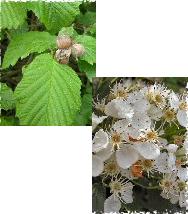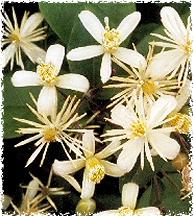Wildflower Facts and Search
Butterfly / Moth Facts and Search
  
|
Trees and Hedge Plants Mixed hedgerows are important wildlife habitats, providing food, nesting sites and shelter for birds, small mammals and insects. A hedgerow also provides safe corridors for small mammals to travel from one area to another, and songposts and viewpoints for birds to perch on. Once your hedge is established (after 3 years or so), you can further increase its wildlife value by planting climbers such as Honeysuckle and Wild Clematis to wind their way amongst the hedge plants. Honeysuckle is popular with moths, butterflies, bees and birds - thrushes, robins, tits and blackbirds will feast on the berries and seeds, and another bird in particular, the Pied Flycatcher, uses Honeysuckle bark as part of its nesting material. Wild Clematis provides food and nesting material for birds, moths and bees. The information contained in the links below show just how many species of butterfly, moth, bird, mammal and other insects our native trees support. Some are veritable micro-cities for wildlife. Hedgerows in the coutryside have declined dramatically over the years, their decline in turn affecting the numbers of wildlife. By planting even one native tree you will be helping wildlife in some way. Planting a Wildlife Hedge Maintenance of Your Wildlife Hedge First of all, you need to consider what sort of hedge you are aiming for - is it going to be a wildlife hedge, a security hedge or barrier, for example. If you are planning to plant a wildlife hedge you need to bear in mind that this will not be regularly pruned and so will grow tall, and so you need to ensure you haev the space for it - a single row hedge could grow to be as much as 5 ft wide when fully mature after a number of years; a double row hedge even wider! If you want a hedge primarily as a barrier against intruders you might want to consider predominantly thorny plants. If, on the other hand, your hedge is just serving as a boundary or divider then you an quite happily trim it every year - but at the expense of fruits and berries for wildlife. The most wildlife-friendly hedge includes Hawthorn as the bulk of its make-up. Again, opinion varies as to how much Hawthorn to include, ranging from 25% to 75%. However much hawthorn you decide to incorporate, plant up the rest of the hedge with around four other species in varying amounts. It is a good idea to look at other native hedges in your surrounding area to see what plants they consist of and then plant the same in your hedge so that you are keeping your plants native to your local area. |
|
Of course, the hedge doesn't have to be mixed species, it could all be
of one variety. You don't even have to have room for a whole hedge - just
a few or even one native tree will be of some wildlife value. Incorporate
hedgerow trees (such as Crab Apple, Field Maple and Hazel) intermittently
in the hedge, which you can let grow a bit taller than the hedge.
For information on individual tree species please click here |
|
